
New Photos
July 2, 2006
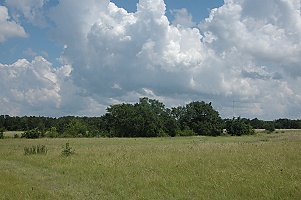 |
|
| Landscapes in Texas always involve skyscapes as well--here a look across the near meadow on a bright, hot June day with clouds forming. | |
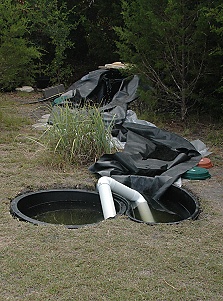 |
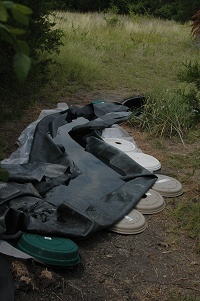 |
| Messy as it is at this stage, here's the whole layout of the Owl Pavilion wildlife waterer. At the upper (far) end is the "spring" and "grotto" under construction, with a stream leading down to two preformed pools. On the right is the kidney shaped one, and the round one is to the left. That funny-looking white thing is the siphon which will (eventually) maintain the same water level in each. The pump will be in the round pool, with the return hose running up under the lip of the stream. The two deeper pools will provide a safety margin of depth for the pump, so the system should be able to handle several days without attention even in hot weather. In addition, aquatic plants such as water iris, water willow, mint, and even a water lily will thrive in this end, providing habitat for dragonfly and amphibian larvae. | Downstream from the "spring", the stream heads for the preformed pools; the width and depth will vary to provide different drinking and bathing opportunities for different species. We plan to put gravel and rocks in the stream, as well, to make it more natural. |
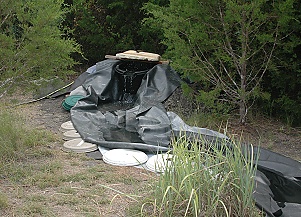 |
|
| The stream curves around an existing clump of Indiangrass, which will provide perches for dragonflies when the system is complete. The shallow stream has irregular depth and width, providing a variety of watering sites for birds and other wildlife. When complete, another slab of rock will sit over the one you see here, with water emerging from between the two and trickling over the edge. The 23 circular enclosure under the rock is designed to provide shaded water and also a sound-reflecting surface so the water can be heard even from the observation deck. | |
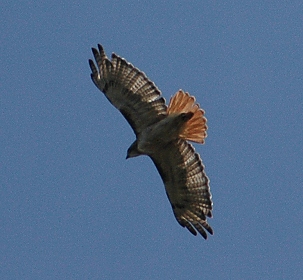 |
|
| A week ago, this red-tailed hawk investigated us but rose quickly on a thermal when I pointed the camera at it. It's fun when you can get strong sunlight through birds' feathers. | |
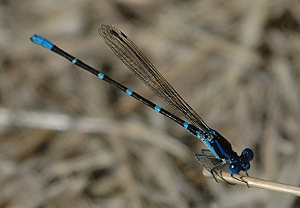 |
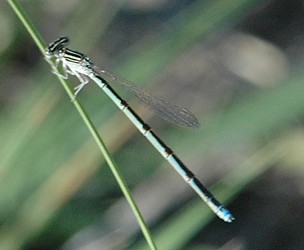 |
| While sitting in Owl Pavilion last week, I spotted the bright colors on this little damselfly. It's a Blue-ringed Dancer, Argia sedula. This makes the third Argia species on the place--though I haven't seen nearly as many Kiowa Dancers this year as I did last.. | Sometimes you get half-lucky. Seeing this tiny damselfly at all was pure luck, but it was late, the sun already low, and the wind was buffeting the grass stem on which it perched. This is the best I could do, and then it flew away. I don't know what it is, or if I'll ever see it again. My impression was that it was as tiny and delicate as the Citrine Forktail I photographed in early spring, but I don't know. |
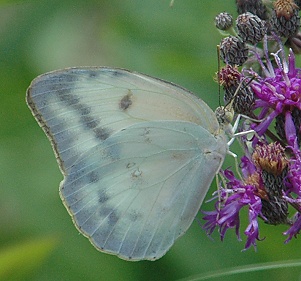 |
|
| In the sun, nectaring on ironweed, this butterfly looked snowy white--especially since there was a monarch nectaring on the same gorgeous purple flowers. (No, I couldn't get them to pose together. They were far too fluttery and active.) Actually, this the white form of the female Large Orange Sulfur, Phoebis agarithe. There are butterflies in the "white"group with wing markings, but that faint blush of color on the forewing helps identify this one | |
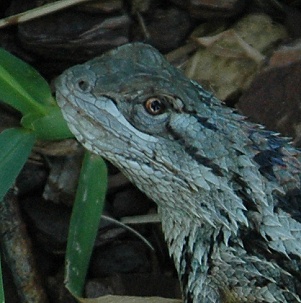 |
|
| Coming back through the yard one day, I almost stepped on this well-camouflaged Texas Spiny Lizard. She froze, just tilting her head to look up at me--so of course I had to take a picture. | |
| This was a week of lost opportunities, too: errors with the camera that cost me a good picture of the male summer tanager who obligingly posed and sang while I messed up the image, and ditto the "different" spreadwing damselfly and a dragonfly up at Fox Pavilion. Apparently I got too cocky about knowing my equipment...the more settings you start messing about with, the easier it is to forget to change them back--especially in the excitement of seeing a new species. | |
![]()

